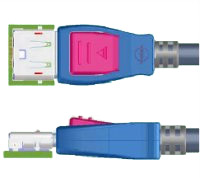New video interface to replace everything else
 The VESA video equipment standards association on Wednesday officially approved a new type of interface for connecting any digital video signal source to modern LCD displays. The standard DisplayPort in the amended version 1.1 is ready to replace the obsolete VGA, DVI and various embodiments of LVDS. In this role, it partially competes with the currently standard HDMI interface, which is used only in Hi-End technology.
The VESA video equipment standards association on Wednesday officially approved a new type of interface for connecting any digital video signal source to modern LCD displays. The standard DisplayPort in the amended version 1.1 is ready to replace the obsolete VGA, DVI and various embodiments of LVDS. In this role, it partially competes with the currently standard HDMI interface, which is used only in Hi-End technology.The need for a new unified interface for connecting various displays with any devices that need to display complex images has emerged relatively recently, as digital technology has spread. Many eminent manufacturers of hardware would not be indifferent to get one single technology for connecting external devices like monitors or projectors to PCs and players, as well as embedded screens in dozens of types of other consumer electronics. This would greatly simplify the creation of all such equipment, and its use by consumers.
As a result, with the support of AMD, Intel, nVidia, Samsung and many other interested companies, VESA developed a fast compact interface, plainly called DisplayPort. With all its outstanding technical characteristics, it is much simpler until quite recently reigned in the professional and semi-professional technology of the DVI standard. You can see a comparison of the connectors of the two in the photo below.

')
By cable, which looks a little different from ordinary USB-wire, you can simultaneously transmit multi-channel audio and video in the resolution of 2560 × 1600. However, in this case it is not recommended to use a cable longer than three meters. But if you have enough video in HD 1080 format, then you can safely spread the entrance and exit to 15 meters. The standard assumes the ability to transfer images with a color depth of 16 bits for each channel, which fully meets the most modern requirements.
Using this interface as internal in the near future will be the result of replacing LVDS-type tires in monitors (including laptops), TV panels, scanners and other devices that work with images. Despite the advantages of LVDS (using the same technology, for example, Serial ATA), the bandwidth of such channels for video applications is not enough today. In addition, AMD plans to use the DisplayPort interface in its promising Fusion platform, which will combine the CPU, GPU and part of the chipset on a single chip. In the future, it will also surely find its use in various portable devices.
 Everything would be fine, but the cloudless future of DisplayPort “in every iron” is overshadowed by the presence of the HDMI interface on the market, which has been occupying a niche for the most expensive video technology for three years. HDMI has almost identical characteristics and was originally designed to work in demanding systems. However, this remarkable, undoubtedly, technology has one major drawback - it is closed and belongs to the consortium that created it, which requires a license fee for each device that supports it. Whereas any VESA standard assumes its free, open and free use by anyone.
Everything would be fine, but the cloudless future of DisplayPort “in every iron” is overshadowed by the presence of the HDMI interface on the market, which has been occupying a niche for the most expensive video technology for three years. HDMI has almost identical characteristics and was originally designed to work in demanding systems. However, this remarkable, undoubtedly, technology has one major drawback - it is closed and belongs to the consortium that created it, which requires a license fee for each device that supports it. Whereas any VESA standard assumes its free, open and free use by anyone.In conjunction with strong HDMI is designed to work interface UDI, aimed at the use in PC graphics systems. The narrow specialization of these technologies in comparison with DisplayPort also, perhaps, should be regarded as a minus.
VESA is currently developing DisplayPort version 2.0, increasing throughput and adding new features. The main feature of the current version 1.1 was the introduction of HDCP 1.3 content protection technology, which is used when recording Blu-Ray and HD-DVD discs, as well as in HDMI and DVI interfaces. This will allow to release video on disks without regard to user "hardware".
Source: https://habr.com/ru/post/6413/
All Articles